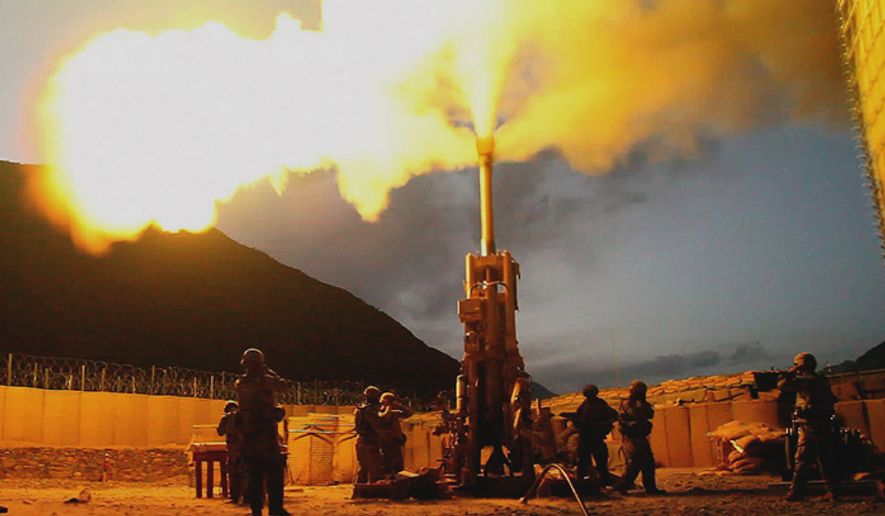The Army is thinking big — really big — in its quest to maintain military dominance over global adversaries.
Army officials say they are putting more emphasis on research into a “game changing” cannon with an unprecedented range, one that could prove crucial in a conflict with a potential adversary such as China. The Strategic Long-Range Cannon (SLRC), which could reach well over 1,000 miles, represents a key piece of the Pentagon’s push for more advanced artillery capable of targeting enemy positions from distances that were once unimaginable.
The cannon, which the Army hopes to test by 2023, is part of the Pentagon’s broader effort to install “long-range precision fires” in potential battlefields around the world. The technology behind the SLRC remains in development, but Army officials said bringing such weapons into the arsenal is critical as the military prepares for the next era of warfare.
In an ironic twist, the quest for a modern longer-range artillery piece also marks a return to an earlier era for today’s modern militaries. “Super-guns” were eagerly developed by the powers drawn into World War I, and Adolf Hitler pushed Nazi scientists (unsuccessfully) to develop a V-3 “Super Cannon” to target London from bases across the English Channel.
“If you look at doctrinally how the U.S. military uses long-range fires to shoot and then maneuver … it’s one of the most important capabilities that we have as an entire Department of Defense,” Army Secretary Ryan McCarthy told The Washington Times in an interview last week.
Such weapons, he said, can “reverse the paradigm” for potential adversaries who are now spending heavily on capabilities to deny U.S. forces access to key areas and battlefields and who may have control of the airspace above certain future battlefields, Mr. McCarthy said.
Indeed, China has put a heavy priority on a strategy known in military circles as anti-access and area denial (A2AD). Such a policy — a combination of defensive systems, artillery, radar and other tools — seeks to deny an enemy the ability to occupy or move through a specific area of land, air or sea.
The strategy, specialists say, would be vital if Chinese forces mount a full-scale invasion of Taiwan and need to keep American forces from coming to the island’s aid. If executed correctly, the A2AD approach could keep U.S. ships, planes, drones and ground forces away from the fight.
Arms race
Researchers say China is trying to ramp up its A2AD strategy even further by incorporating Russian-made S-400 missile defense systems and other weapons that could slow down or even halt the U.S. ability to move planes and ships across the Pacific.
“China continues to improve its area denial capabilities and reports speculate that the country plans to acquire improved S-400 air defense systems from Russia for deployment in the region,” the Missile Defense Advocacy Alliance says on its website. “Anti-satellite weapons are also believed to be employed by China to maintain A2/AD in the Asia-Pacific, and would be used to disrupt or even completely deny U.S. satellite communication and GPS capabilities.”
U.S. officials say that’s where long-range precision guns could play a huge role by providing a high-tech version of artillery-covering fire. They theoretically would be able to target areas that ships and planes simply couldn’t reach, giving U.S. forces a relatively safe and effective way to fight back.
“That integrated system challenges even our most sophisticated aircraft and challenges our most sophisticated ships to gain access to the area,” Col. John Rafferty, director of the Army’s long-range precision fires cross-functional team, told Defense News this month. “That layered enemy standoff at the strategic level was really the fundamental problem. One of the ways to solve that problem is to deliver surface-to-surface fires that can penetrate this [anti-access, area-denial] complex, disintegrate its network and create windows of opportunity for the joint force to exploit.”
Col. Rafferty last year suggested the SLRC could involve a scaling-up of the existing arsenal, perhaps the use of new, rocket-boosted shells that could be fired from the M109 howitzer.
Still, the Army’s long-range cannon program is years from delivering a prototype. In addition to the technological challenges of firing projectiles accurately at targets 1,000 miles away — roughly the distance from Washington, D.C., to Topeka, Kansas, the Pentagon also must ensure that the cost of the advanced weapon doesn’t become prohibitive.
Officials said research is underway at the Center for Army Analysis and the Research and Analysis Center at White Sands Missile Range, key hubs for Army research and development.
Mr. McCarthy, Defense Secretary Mark Esper, Joint Chiefs of Staff Chairman Gen. Mark Milley and a host of other top Pentagon officials have stressed the importance of long-range precision weaponry and how it is a critical piece of the nation’s 21st-century security strategy.
If the long-range cannon comes to fruition, Mr. McCarthy said, it will represent a massive step forward.
“We have run all the simulations that shows the feasibility we’ve procured, the material to start this,” he told The Times. “That capability, in particular championed by Gen. Milley personally, is one that we think … can yield the outcome [that] would be a game-changing technology for us.”
• Lauren Toms can be reached at lmeier@washingtontimes.com.
• Ben Wolfgang can be reached at bwolfgang@washingtontimes.com.




Please read our comment policy before commenting.